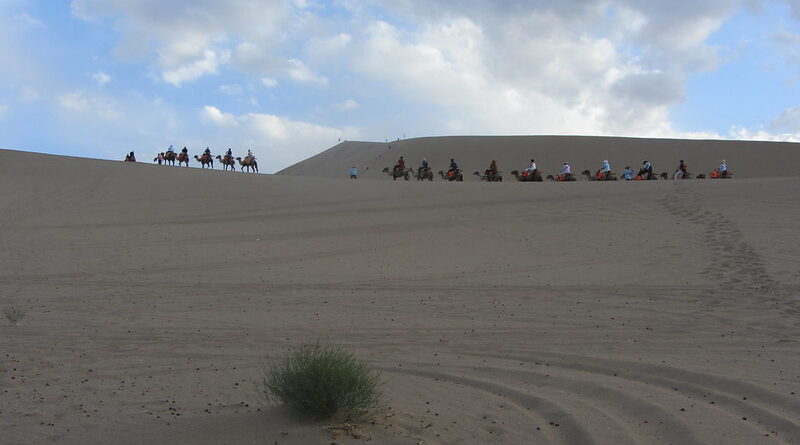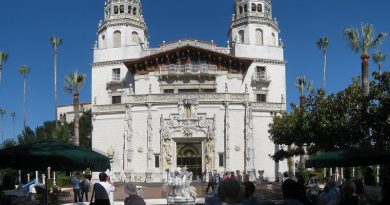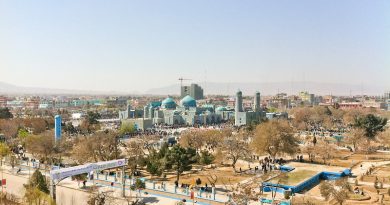The History of the Silk Road
History
Perhaps the most essential development in the cultural exchange between the Eastern and Western worlds, the Silk Road was a network of critical trade routes linking Europe and Asia. These routes stretched from the the Mediterranean region to as far as Japan and included a plethora of land and sea trails. The increasing prevalence of the Silk Road had not only a profound material effect on the world but was also critical in the cultural development of several civilisations around the world.
Origins
The foundations of the Silk Road were laid and built upon thousands of years ago. Trade between China and Middle Eastern countries can be dated back as far as 2000 BC, while traces of Chinese silk can be dated back to 1000 BC in Ancient Egypt, which indicates trade between the two areas. Little is known about these early links, and they were certainly not as substantial as they would later become. The Persian Empire maintained a complex trade route through the entirety of its territory to Ancient Greece, which could be seen as a progenitor to the more well-known Silk Road routes. Arguably the first significant development in the establishment of the Silk Road came during the reign of Alexander the Great, whose conquest of Central Asia brought his Greek Empire within spitting distance of China. The Greek presence in Central Asia, which would last for 300 years, saw the commencement of the cultural exchange between the West and the East, which would flourish for millennia. It is believed that during this period, in around 200 BCE, that the first Chinese contact with the West was established.
China was the principal instigator of the Silk Road’s transition into the vast network it became. During the Han Dynasty, China became increasingly interested in Western trade as its empire expanded deeper into Central Asia. The Hans were motivated by both diplomatic and materialistic interests as more and more routes connecting East and West opened up. The Hans established routes on land and sea, which saw trade begin to increase significantly, although they were not as complex as they would eventually become.
The Roman Empire were also an important force in the Silk Road becoming a global phenomenon. The Roman takeover of Egypt in 30 BCE saw its trade with Eastern countries increase significantly. Having essentially displaced the Hellenic Empire, the Romans inherited many of its prototypical trade routes with Eastern territories. The dominant force that it was, the Roman Empire galvanised trade links between East and West, its significant wealth causing demand for artisanal products such as silk (hence the Silk Road) to skyrocket. The Empire’s collapse in the 5th Century caused trade between East and West to cool, due to the absence of such substantial demand. However, this initial contact set the foundations for the Silk Road.
Marco Polo
One of history’s most iconic explorers of all time, Marco Polo was a figure whose exploits were critical in opening up a dialogue of trade and communication between the East and the West. An Italian merchant born into a family of explorers, Marco Polo can be credited with reigniting the interest of Europeans in visiting the Far East. Inspired by the travels of his father and uncle Niccolo and Maffeo, who had met Kublai Khan, a powerful Mongol leader, on their Asian travels, he joined them on their next journey in 1271, not to return home for nearly 25 years. It is difficult to present an entirely factually accurate account of Polo’s journeys, with some questioning the accuracy of his claims.
During his travels, Polo traversed the routes which now fall under the Silk Road, reaching modern-day China. He became associated with Kublai Khan, and purportedly travelled throughout his domain whilst under his employ, returning to Venice shortly after Khan’s death, which triggered the downfall of the Mongol Empire
Upon his return to Venice, he bore substantial newfound wealth, converted into gemstones. He wound up in Genovese captivity shortly after his return in a conflict with Venice. During this impriisonment, he dictated the stories of his travels, which eventually became The Travels of Marco Polo manuscript, which circulated widely throughout Europe and played a critical role in inspiring a new generation of travellers, most notably Christopher Columbus.
Polo’s travels, despite the ambiguity over their truthfulness, nonetheless left an enduring legacy, inspiring interest in the Far East and its potential riches. They left an important contribution to cartography and left a template upon which figures of the Age of Exploration would build upon.
What Was Traded
As its name suggests, the Silk Road’s origins lay in the trade of valuable Chinese silk with Western commodities. Originally, during the Hellenic Period, the main Western item traded were horses. The Chinese were taken aback by the Ionian horses, which were unlike any they had previously seen. This is often considered to be the initial main exchange between East and West, giving the Silk Road its name.
However, as the routes developed and grew increasingly complex along with the cultural exchanges they enabled, a plethora of commodities were traded. Other commodities included ivory, gold, silver and wool. Spices and foods were also an important item of trade, opening up territories to new novelties they had never experienced before.
Most important however is the cultural exchanges, which trade along the Silk Road allowed. The very fabrics of cultures were altered and grew increasingly linked as commodities, languages and ideas found new exposure elsewhere. The Silk Road played a fundamental role in the establishment of cosmopolitanism, which is so prominent around the world today.
Routes
Northern Route: A critical route in the Silk Road reaching from Xian, Northern China, through the Taklaman Desert through the Persian and Parthian Kingdoms and eventually to Rome. This is considered to be the first major route of the Silk Road, defined in the 1st Century BCE, and was used during the Han Dynasty. This route had a number of branches.
Southern Route: A more cohesive, singular route, which connects China and Pakistan through the Karakoram mountains. This route remains intact today as the Karakoram Highway. This Southern Route was essentially a straight, lateral line bisecting the Eurasian continent through Afghanistan, Iran and towards the Mediterranean.
Tea Horse Road: A critical route of the Silk Road, this opened up access to India from China. This route travelled through Tibet, Burma and finally Bengal. It was, as its name suggests, important in transporting tea as well as other commodities such as salt. It was indirectly pivotal in opening up the riches of India, mainly spices, to the West, providing an accessible route for later travellers.
Maritime Silk Road: Although the Silk Road is most often considered to be a land-based route, people often neglect the importance of sea travel to the emergence of trade. The Maritime Silk Road was a vast network encompassing several of bodies of water, particularly the Indian Ocean, the South China Sea, the Persian Gulf and the Arabian Sea. It allowed travellers to bypass the sometimes dangerous land routes, providing another important outlet for trade.
Caravanserai: These were structures which emerged as travelling became increasingly common along the Silk Road routes. Caravanserai were essentially roadside inns where travellers could rest whilst journeying across the Silk Road. Varying in levels of opulence, they were typically rectangular buildings and provided water and other supplies to travellers as well as lodgings. Their construction reflected the increasing importance of the Silk Road and the need for infrastructure along it to accommodate the significant increase of travellers. Several Caravanserai ruins remain
intact today, most notably in Iran and Armenia where they were highly common.
Silk Road Cities
Samarkand: One of the oldest continuously inhabited cities in Central Asia, Samarkand is located in what is now known as Uzbekistan. Samarkand rose to prominence due to its positioning along the Silk Road and became a major centre for trade as travel became increasingly common. Samarkand became one of Central Asia’s most prosperous cities, its positioning at the mid-point between China and the Mediterranean made it a critical location for travellers along the Silk Road. Marco Polo wrote about it in his travels, which arguably popularised it amongst Western travellers. Samarkand’s importance as a trade hub saw it become an important cultural centre, eventually becoming the intellectual epicentre of Central Asia.
Merv: Although it is no longer an inhabited city, the ruins of Merv marked the location of a significant Oasis-City along the Silk Road. A number of different cities were located on the ruins of Merv during Hellenistic, Arab, Turkish, Mongol and Uzbeki periods of dominance of the territory. As a result, the site has seen several different cultures and civilisations leave their mark on the city, a process which intensified as West/East contact became more commonplace.
Xi’An: One of China’s most important modern-day cities, Xi’an emerged as an important urban centre as the capital of the Tang Dynasty, which coincided with the rise of the Silk Road. Xi’an is considered to be the starting point of the Silk Road and China’s window into the Middle East. Indeed, a substantial Muslim population remains prevalent in the city today.
Aleppo: A pivotal trade centre of the Silk Road, Aleppo’s close proximity to the Mediterranean Sea and the Euphrates Valley ensured its importance as trade between East and West opened up. Aleppo was famous for its vast 13 KM bazaar, which served as an important trading centre for commodities and cultures.
Mosul: Located in modern-day Iraq, Mosul arose as a key Silk Road city at some point prior to the 10th Century and evolved into one of the Middle East’s most diverse urban centres. Mosul was known for its economic prosperity, resulting from its artistic and industrial production. It became known particularly for being one of the Middle East’s most important textile centres as well as a key producer of crude oil.
Legacy
The Silk Road’s importance in history cannot be overstated. On a material level, populations were exposed to goods they had never previously encountered, which by extension reshaped various areas of culture. More importantly, the cultural impact is immeasurable, allowing both Eastern and Western ideas, philosophies and practices to be exposed and embraced by new audiences. Furthermore, the Silk Road caused travel to regain popularity in an significant way, instigating a new Age of Exploration. The Silk Road’s explosion in popularity caused the barriers between the Eastern and Western worlds to collapse and begin to merge, leaving the foundation to the cosmopolitan world we live in today.




